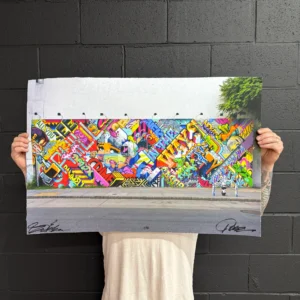

In 2025, two titans of contemporary street art, POSE (Jordan Nickel) and REVOK (Jason Williams), unveiled a new limited edition print titled Uphill Both Ways. Signed by both artists and produced in an edition of 150, this archival pigmented print on premium matte paper represents more than a collectible artwork — it embodies a narrative woven through decades of urban expression, rebellion, and evolving artistry.
Based on their 2013 mural painted on New York’s iconic Bowery Wall, Uphill Both Ways captures a moment when graffiti transcended its illegal, ephemeral roots to enter the rarefied spaces of institutional acknowledgment and fine art. Through this new print, POSE and REVOK reflect not just on a shared past but on the very essence of contemporary art’s shifting boundaries.
The Bowery Wall: A canvas of legends
Since the 1980s, the Bowery Wall in Manhattan has stood as an open-air museum for graffiti and street art luminaries. Originally an advertising space, it became a cultural landmark thanks to Keith Haring’s transformative 1982 mural. Over the decades, it has hosted works by Shepard Fairey, Kenny Scharf, Lady Aiko, and more — each iteration a snapshot of urban creative energy.
In 2013, POSE and REVOK were invited to leave their mark on this hallowed surface. Their collab was not merely a joint effort but a synthesis of two creative philosophies born on the streets and refined in studios. Now, over a decade later, Uphill Both Ways resurrects this moment in a format that transcends the transience of the original mural, offering collectors a chance to own a piece of street art’s living history.
POSE: From sign-painter to Pop Art icon
Jordan Nickel, known as POSE, embodies the transformation of a graffiti writer into an acclaimed contemporary painter. His style integrates sign-painting techniques, Pop Art motifs, and the frenetic spirit of graffiti. There’s a deliberate tension in his work: the polished lines and bold colors reminiscent of Roy Lichtenstein collide with the improvisational marks and drips that echo his tagging roots.
POSE’s journey is deeply autobiographical. He draws from a lifetime immersed in consumerism, brand iconography, and mass media’s visual language. His canvases feel like crowded city billboards — layers upon layers of commercial symbols, bright colors, and urgent messages. And yet, beneath the visual cacophony, there is an intimate sincerity: a self-portrait of an artist navigating a hyper-commercialized world while retaining personal authenticity.
Uphill Both Ways channels this duality beautifully. The print’s bold composition invites immediate visual impact, but a closer examination reveals subtle textures and unexpected details, reflecting the artist’s internal tug-of-war between the commercial and the personal.
REVOK: From vandal to vanguard
Jason Williams, aka REVOK, embodies the narrative arc of street art’s legitimacy. Starting as a graffiti writer in California’s streets and rail yards, REVOK gained notoriety for his large-scale, intricate pieces and fearless approach. His early work celebrated graffiti’s guerrilla ethos — ephemeral, rebellious, and deeply rooted in community.
However, over the past decade, REVOK has transcended his outlaw beginnings, evolving into a respected studio artist focused on process and abstraction. His studio practice integrates industrial materials and custom-made tools, creating works that are systematic yet retain the imperfections of the human hand. This evolution mirrors the journey of modernist painters like Frank Stella or minimalist sculptors such as Donald Judd, who examined the interplay between machine precision and human touch.
In Uphill Both Ways, REVOK’s contribution is evident in the geometric rhythm and carefully orchestrated chaos. The print captures his fascination with modularity and mechanical repetition, yet it retains an organic vitality that breathes life into its structured patterns.
Literary echoes: The struggle embodied
The phrase “uphill both ways” carries deep metaphorical weight. Traditionally evoking the exaggerated hardships of past generations (“When I was your age, I walked to school uphill both ways”), it becomes a poignant title for artists whose careers have been defined by resistance — against legal systems, societal norms, and the limitations of the art world.
In literature, characters grappling with Sisyphean struggles populate classics from Albert Camus’ The Myth of Sisyphus to Kafka’s The Trial. Similarly, POSE and REVOK represent figures continually pushing against the slope of societal and artistic expectations. Their work embodies the tension between fleeting illegality and lasting institutional acceptance — a paradox at the heart of contemporary street art.
Historical context: From vandalism to galleries
The journey of street art from back alleys to galleries has been fraught with contradictions. In the early days, graffiti writers were often dismissed as vandals, their work quickly painted over or removed. Yet by the early 2000s, street art began to enter mainstream consciousness, buoyed by figures like Banksy, Shepard Fairey, and KAWS.
POSE and REVOK’s careers parallel this timeline. As cities cracked down on illegal graffiti, artists began transitioning into studio practices, bringing their raw, urban aesthetics indoors. This shift wasn’t merely pragmatic; it was a redefinition of the artist’s relationship with audience, permanence, and authorship.
By creating Uphill Both Ways as an archival print, POSE and REVOK confront this evolution head-on. The print is both a tribute to the impermanent nature of their mural and a means of preserving it beyond the physical decay of the Bowery Wall.
Materiality and the print as artifact
Printed as an archival pigmented print on premium matte paper, Uphill Both Ways reflects an obsessive commitment to quality. The choice of full-bleed with deckled edges nods to fine art traditions, evoking a sense of preciousness that contrasts with the ephemeral essence of graffiti.
Deckled edges, a hallmark of handmade paper, serve as a metaphor for imperfection and authenticity. They remind us that even within highly controlled, editioned art, the human hand and its imperfections remain central. This tension mirrors REVOK’s fascination with the interplay between machine-like precision and human error.
Contemporary relevance: Street art and commodification
In 2025, street art’s commodification is both celebrated and critiqued. On one hand, artists like POSE and REVOK are recognized globally, their works selling for significant sums and entering prestigious collections. On the other, critics argue that street art’s co-optation by luxury brands and art fairs dilutes its rebellious spirit.
Uphill Both Ways engages with this conversation rather than shying away. By releasing a limited edition print, the artists commodify a once-illegal act, but they do so on their terms — controlling production, quality, and distribution. The print becomes both a product and a statement, challenging buyers to consider the tension between authenticity and market value.
Global reception and exhibitions
POSE and REVOK have exhibited globally, from Los Angeles to Dubai, each show expanding their narrative. REVOK’s installations in the Museum of Contemporary Art Los Angeles and the Pasadena Museum of California Art positioned him within institutional frameworks traditionally resistant to graffiti. Meanwhile, POSE’s large-scale murals and collaborations with design houses have cemented his place at the intersection of high art and commercial design.
Their global presence mirrors the globalization of street culture itself. Once hyper-local, street art is now a global language — adaptable yet rooted in shared experiences of urban life.
Flow
Uphill Both Ways is more than a print; it is a distilled essence of two artists’ journeys through chaos, critique, and creativity. It stands as a testament to the enduring spirit of street art, its capacity for transformation, and its power to bridge worlds — from alleyways to auction houses.
POSE and REVOK invite us to reflect on the tensions that define contemporary life: permanence versus transience, rebellion versus commodification, chaos versus control. In a world increasingly obsessed with speed and disposability, their work insists on contemplation and confrontation.
As collectors unroll these prints and admire the layers of color and texture, they hold more than an image — they hold a narrative. A narrative of artists who walked uphill both ways, carrying the weight of their histories, communities, and creative integrity. It is a narrative still being written, one edition at a time.
No comments yet.








